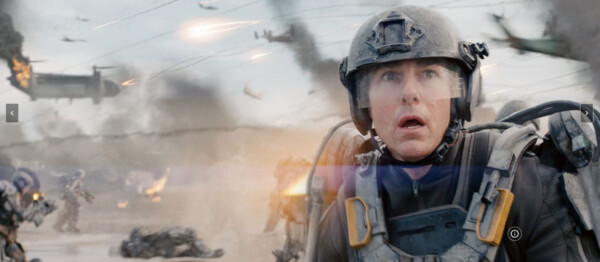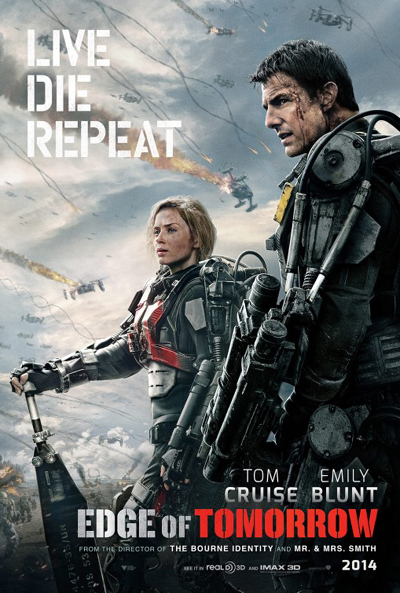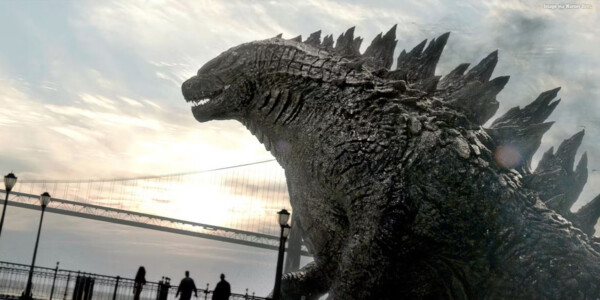Del and Mladen review ‘Edge of Tomorrow’

Image courtesy of Warner Brothers.
—
“Edge of Tomorrow” Starring Tom Cruise, Emily Blunt, Bill Paxton. Directed by Doug Liman. 113 minutes. Rated PG-13.
Del’s take
Didn’t Mladen, at some point during one of his hyperbolic rants, swear he’d never see another PG-13-rated movie? Didn’t he say they were all crap?
Well, guess what?
He broke his vow and attended “Edge of Tomorrow,” the latest Tom Cruise sci-fi vehicle, and after the movie was over you should have heard him, squealing like a little girl who’d just been given a peck on the cheek by Justin Bieber. He not only saw another PG-13-rated movie but he loved it.
Mladen, you phony.
His enthusiasm, however, is well-deserved. “Edge of Tomorrow” is a terrific summer movie, carrying the right balance of humor, tension, and spectacle. Your ticket-buying dollars will not have been wasted on this one.
In “Edge of Tomorrow,” an alien race we call “Mimics” has invaded the earth and is swallowing up Europe. Unless they’re stopped, mankind faces the same fate he inflicts on so many animal species of this planet. Cruise’s character, Major William Cage, is sent to the fight despite his credentials as a public information officer for the military. During the battle he kills an “alpha,” a particular kind of alien that, in dying, bestows him with the ability to restart the day each time he dies. (Believe me, there are no groundhogs in this movie, and if there were, they’d all be exterminated.) Through repeating his experiences he’s able to learn and survive a little longer, until he meets up with Sgt. Rita Vrataski (Emily Blunt), who underwent the same experience and learned there’s a very bad alien pulling all the strings. Their mission, which they choose to accept, is to exterminate that alien.
This movie presents so many pluses it’s hard to list them all. The writing is excellent. The dialogue is snappy, at times hilarious, at other times deadly earnest. Pacing, internal logic, respites from tension – they’re all handled with a canniness that speaks to the skills of the writers and the director.
Acting is top notch. Tom Cruise is a sympathetic and realistic character in the bones of the unwilling and frightened Major Cage, and he grows throughout the movie. Emily Blunt is a tough badass who has her vulnerabilities – and might I add it’s a pleasure to see a strong woman in a movie again – and Bill Paxton is funnier than his role in “Aliens.”
Speaking of which, the aliens in “Edge of Tomorrow” are truly alien. I take my hat off to the person who designed them. They look like nothing you’ve seen.
“Edge of Tomorrow” is not “deep,” meaning it won’t be in line for a best picture award. But it’s nice to see Cruise in a winner. It’s nice to see a movie that isn’t based on a sequel or a prequel or a remake of a remake. It’s nice to see a well-written, smart, funny and exciting film again. I was beginning to wonder if I ever would.
I almost clapped at the end of “Edge of Tomorrow,” and if a movie review can make a sound, that’s likely what you hear. Go see the movie. I’d rate it a solid A.

Mladen’s take
It would be easy to dismiss “Edge of Tomorrow” as a trite film because the trailers make it look and sound like “Ground Hog Day” meets “Halo.” But, that would be an error.
Despite its flimsy PG-13 rating, “E of T” is very good. The script and acting – Tom Cruise as Cage and Emily Blunt as Vrataski in the lead roles and Bill Paxton supporting as Farrell – were top notch. Plus, computer-generated graphics were used to enhance the plot, rather than conceal poor writing, silly coincidences that keep a weak story flowing, and crappy, underdeveloped characters typical of summer blockbusters.
Del summed the movie nicely, so I won’t bother. “E of T” is a film worthy of the big screen and big ticket prices moviegoers have to endure these days.
“E of T” is a sci-fi adventure built around its stars. Don’t get me wrong, there’s plenty of gun and grenade play and lots of CV-22-like machines blown out of the sky, but it’s the movie’s characters that keep your attention.
Cage transitions nicely from a selfish and naïve military public affairs propagandist at the beginning of the film to a man clearly thinking about someone other than himself by the end. He dies many times, often in funny ways.
Vrataski is tough from the get-go and the brains behind the operation to whack the Omega, a time-warping brain, that controls the Mimics, hyper-mobile alien troops that have conquered continental Europe.
“Edge of Tomorrow” isn’t perfect, but could have been – yeah, Del, here it comes – if the studio dedicated it to entertainment for adults by going R. Yes, the producers would have made less money, but, in exchange for less change, “E of T” could have gone down in moviedom sci-fi history as masterful. Was “Alien” rated PG(-13)? Was “The Matrix” rated PG(-13)? Was “District 9” rated PG-13? No, no, and no. More realistic battle scenes would have helped “E of T.” Vivid blood spray, graphic skin, muscle, and organ disintegrations after impacts by projectiles or crashes, full-bore cussing, and reproductive urge tension between handsome Cage and beautiful Vrataski would have burnished the movie’s credentials. Instead, we get sterilized deaths and constrained language even when Mimics are running amok and slicing through exoskeleton-equipped human soldiers.
Lukewarm rant aside, I would see “Edge of Tomorrow” again in the theater if I could afford it. And, “E of T” will become part of my Blu-Ray collection when it’s released for home viewing.
Though it troubles me to no end, I completely agree with Del on this one. “Edge of Tomorrow” is a solid A.
Mladen Rudman is a former journalist and technical editor. Del Stone Jr. is a former journalist and author.

Image courtesy of Warner Brothers.
“Godzilla” Starring Aaron Taylor Johnson, Elizabeth Olsen, Brian Cranston. Directed by Gareth Edwards. 123 minutes. Rated PG-13.
Mladen’s take:
The obvious first. The new Godzilla film stinks. Don’t let Del’s opinion fool you. He doesn’t know Godzilla from Godthab … the capital of Greenland.
Discussing the movie’s plot and acting is pointless because its star is nothing more than Godzilla-like. For example, I’m Brad Pitt-like because I’m an upright walking biped.
So, let’s talk monster morphology and physiology from a purist’s perspective.
I’ll use Toho Studio’s last major Godzilla type, the one that debuted in the film “Godzilla 2000.” It’s labeled AG for “Authentic Godzilla.” The Godzilla-like animal in the new film is “Poser.”
Godzilla from afar.
• AG: An upright walking monster with distinct body parts, such as a neck, prominent spine plates mimicking curved blades, and contoured limbs. The tail is longer than AG is tall.
• Poser: A hunched garden slug-like silhouette with a small head attached to an anorexic body that terminates in legs with, get this, cankles. Its back plates are stunted and the tail short, almost stubby.
Godzilla up close.
• AG: Sleek, cat-like head large, expressive eyes looking forward and a mouth featuring large, expressive canines.
• Poser: Small head with nearly colorless beads for eyes tucked into a puffy face, as though the animal was dehydrated from an all-night drinking party. Put together, the face is a blur with its major components – snout, forehead, and jaw – blending into each other almost indistinguishably.
Godzilla’s fire breath.
• AG: A searing plasma, white-amber in color and liquid in texture, projected from the monster’s mouth. It’s launched with a head movement. AG’s head rotates sideways 30, 40 degrees and then juts forward. The monster sometimes takes a step toward its target, maybe to brace against the death ray’s recoil. When the fire breath hits, it explodes, engulfing the target. It is preceded by the spine plates glowing the same vivid color. They heat the air around them, causing convection currents.
• Poser: A feeble blue that looks like its origin is a LED light someone stuck into Poser’s throat. Come on, the death ray is supposed to be generated by nuclear fission, not your local electric company. The spines glow the same soothing blue. There’s nothing intimidating about Poser’s fire breath attack and it barely damages the critter it’s fighting.
A caveat before I address Godzilla’s signature physiological trait, the one that stays the same no matter the monster’s Toho iterations. It could have rescued the new Godzilla film, though the creature’s morphology was sullied.
I appreciate the director taking Godzilla seriously. The monster isn’t mocked as it was in the other Hollywood re-make of Godzilla starring Matthew Broderick. And, there a couple of deferential nods to the Godzilla franchise’s early years.
That three, let alone one, giant monster, can exist today is treated plausibly and sincerely. The acting wasn’t bad and the plot good.
It’s just tough for me to accept that there’s not enough imagination out there in moviemaking land despite the graphics computing power available to modern-day producers and directors to render a classic Godzilla as a force of nature by making it look, well, natural and fearsome and indestructible.
Okay, now the one indelible physiological must for all Godzillas: its roar-screech.
• AG: A growling rumble rapidly ascending in pitch to a banshee wail that then trails off. I don’t know, it’s the sound of a titanium spike scraping across a steel ingot with the frequency slowed and amplified. Or, the roar-screech mimics an elephant’s trumpet inside an echo chamber that amplifies lower tones, while distorting all of the sound.
• Poser: A grizzly bear with laryngitis.
I give the new Godzilla an A for effort and C+ for execution.
And, I’m still trying to figure out why Godzilla faints near the end of the movie. Was it tired from its battle against the other monsters, which resembled a cross between the Gyaos in Gamera movies and the alien invader in “Cloverfield.”
Or, was the director trying to build sympathy for the monster by making it look like it had died to save mankind?
If it was the latter, the director failed because he never developed Godzilla’s personality and, believe me when I say, Godzilla in past renditions had a lot of it.

Del’s take:
I broke Mladen’s heart because I wouldn’t come to his house and listen to a proper Godzilla roar in Dolby SurroundSound.
Sorry, Mladen. Godzilla’s roar, or whether he was fat, or if his head was too small, weren’t on my list of priorities.
What I wanted from “Godzilla” is what I want from every movie – interesting characters who generate empathy, a decent plot, dialogue that works, and a set of rules consistent with the movie’s internal logic.
What I got was boring characters about whom I cared little, a bullet-riddled plot, flat-affect dialogue, and a set of rules that were indeed consistent with the movie’s absurd internal logic.
“Godzilla” opens with a cool segment of backstory: The Pacific nuclear “tests” of the 1940s and ’50s were attempts to kill the giant serpent. The movie then segues to a Fukishima-style disaster at a nuclear facility in Japan. Brian Cranston’s character is the director of the facility, and during the disaster his wife dies in a reactor breach. Jump to today – Cranston’s son, played by Aaron Taylor Johnson, is an explosive ordnance disposal technician who flies to Japan to bail his father out of jail. Seems daddy believes Japanese authorities are hiding something at the reactor disaster site and he’s right – a giant monster has been feeding on the radiation and springs into the world – make that “stomps” – just as Cranston and son arrive at the site.
What follows is a jaunt halfway across the world as the monster makes its way to Yucca Mountain, America’s nuclear waste disposal site (which, by the way, contains no nuclear waste, as its commission was halted by the Obama administration) to meet up with a second MUTO (massive unidentified terrestrial organism) and hatch a batch of monster babies (totally overlooking the two Diablo Canyon nuclear facilities between Los Angeles and San Francisco).
Luckily for mankind, Godzilla is in pursuit as its place as the top alpha predator is threatened by the MUTOs (which bear more than a family resemblance to the monster in “Cloverfield”).
Cranston is able to imbue his role with emotion, but Johnson and Olsen spend most of the film gazing dumbly into the distance. They simply have nothing to say, and it was impossible for me to develop any affection for either. A Japanese scientist, played by Ken Watanabe, is kept by the military as an adviser, but spends most of his time mouthing gassy admonitions about the perils of pissing off Mother Nature.
The characters are wasted.
Special effects are superb, though I grew tired of the gray and brown color palette. The score is at times shrieky, helping the action on the screen to lapse into farce. Edwards’ directorial style is interesting, though I’d say he relied to heavily on foreshadowing. After we’ve seen the monsters, there’s no point in showing us the aftermath of their rampages. Let’s see the buildings tumble!
To me, Godzilla is a metaphor for whatever issue rules the day – nuclear warfare, man tampering with nature, you name it.
But in “Godzilla,” the monster strikes me as a metaphor for the inability of modern storytellers to tell a decent tale.
Overall, I’d rate it a C+.
Mladen Rudman is a former journalist and technical editor. Del Stone Jr. is a journalist and author.